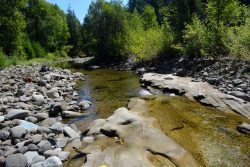
Geologic time is supposed to be slow, and the most solid object should be bedrock. But new University of Washington research upends both concepts: Effects of logging show that human activity can significantly erode bedrock, causing geology to fast forward.
The study, published April 15 in the Proceedings of the National Academy of Sciences, focuses on the Teanaway River, a picturesque river in central Washington state. Lead author Sarah Schanz is a former UW doctoral student who is now a postdoctoral researcher at Indiana University. The study is co-authored by UW Earth and Space Sciences senior lecturer Brian Collins and professor David Montgomery.
“In the last century, we have more river incision in this area than expected. Something caused these rivers to start eroding a lot more,” said Schanz. “We know the Teanaway River has eroded into bedrock before, naturally — it has some terraces that are 1,800 years old. But this current cycle is anthropogenic, or human-driven.”
Read more at UW News »
